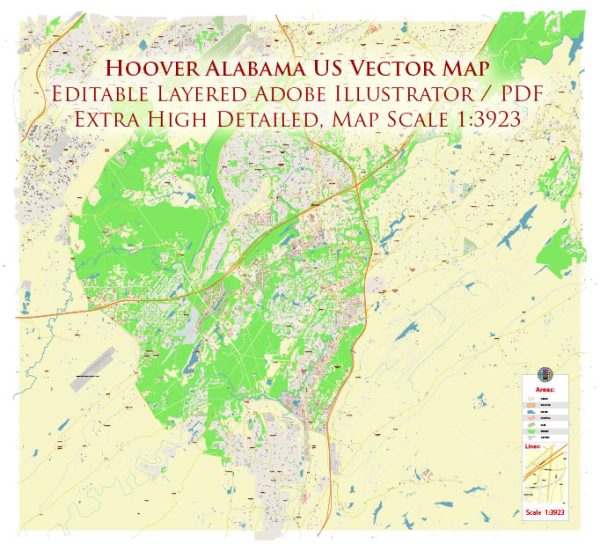A general overview of the economic and industrial characteristics of Hoover, Alabama.
Vectormap.Net provide you with the most accurate and up-to-date vector maps in Adobe Illustrator, PDF and other formats, designed for editing and printing. Please read the vector map descriptions carefully.
Economy:
1. Diversification: Hoover, Alabama, is known for having a diversified economy. While it was historically a residential suburb of Birmingham, the city has experienced significant growth and development, leading to a mix of residential, commercial, and industrial sectors.
2. Retail and Commercial Activity: Hoover is home to several retail and commercial centers, including the Riverchase Galleria, one of the largest shopping malls in the Southeastern United States. This contributes to the local economy through retail sales, services, and employment opportunities.
3. Healthcare and Education: The healthcare and education sectors are also significant contributors to the local economy. The city hosts medical facilities, educational institutions, and related services.
Industrial Overview:
1. Technology and Innovation: Hoover has seen an increase in technology-related businesses and innovation, reflecting broader trends in the region. The presence of tech companies may contribute to job growth and economic development.
2. Manufacturing and Industrial Parks: While not a major industrial hub, Hoover may have some manufacturing and industrial parks that support local businesses. These could include facilities engaged in light manufacturing, distribution, or other industrial activities.
3. Professional Services: Professional services, including finance, real estate, and various consulting firms, are likely to be present, supporting the broader economic base of the city.
Employment:
1. Job Market: The job market in Hoover is diverse, with opportunities in retail, healthcare, education, technology, and professional services. The city benefits from its proximity to Birmingham, which has a more extensive job market and industrial base.
2. Commuting Patterns: Many residents of Hoover may commute to Birmingham and other nearby areas for work, contributing to regional economic integration.
Infrastructure:
1. Transportation: Hoover is well-connected with good transportation infrastructure, including highways and proximity to the Birmingham-Shuttlesworth International Airport. This connectivity supports the movement of goods and people.
2. Education and Healthcare Facilities: The city likely has educational institutions and healthcare facilities, providing essential services and contributing to the overall quality of life.
Real Estate:
1. Residential Development: Hoover has experienced substantial residential development over the years, offering a range of housing options from single-family homes to apartments.
2. Commercial Real Estate: Commercial real estate is also significant, with shopping centers, office spaces, and industrial properties contributing to the local real estate market.
Conclusion:
Hoover, Alabama, exhibits a diverse and growing economy with a mix of retail, commercial, technological, and industrial activities. Its strategic location, well-developed infrastructure, and connectivity to Birmingham contribute to its economic vibrancy. For the most accurate and up-to-date information, it is advisable to consult local government sources, economic development agencies, and recent reports on Hoover’s economy.


 Author: Kirill Shrayber, Ph.D.
Author: Kirill Shrayber, Ph.D.